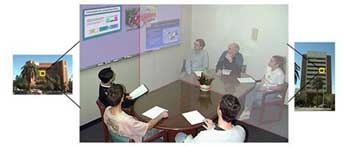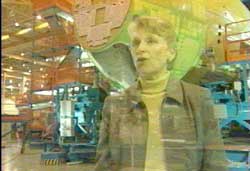Integrated Media Systems Center
University of Southern California
![]()
Revolutionizing the way we work, communicate, learn, teach, entertain and play
| A National Science Foundation Engineering Research Center since 1996 |
The Integrated Media Systems Center (IMSC) seeks to advance multimedia the integration of digital video, audio, text, animation and graphics to dramatically transform the way we work, communicate, learn, teach, entertain and play. By fostering cross-disciplinary programs of research, education, community outreach, and industry collaboration and technology transfer, the Center is taking multimedia to a new level of technological sophistication.
The explosion of integrated media over the past decade into virtually every arena of human activity associated with communications and information sharing attests to the power and importance of this emerging field. A leader in the rapidly growing and ever-changing field of multimedia, IMSC is developing a computer-based environment that supports the creation, sharing, distribution, and effective communication of multimodal information across the boundaries of space and time.
As a leader in the multimedia field, IMSC has developed such unique immersive technologies as three-dimensional face modeling and animation, video rendering methods from multiple projections, and immersive three-dimensional sound environments.
The Center is making substantial progress in advanced teleconferencing, data compression, and wireless communications.
Research
|
|
| Confusion about a manufacturing task is resolved with a remote expert by communication of speech, gestures, 3D scene representations, and database consultation. A representation of the remote expert appears to the worker when he uses the augmented reality glasses. |
The IMSC research program implements the strategic vision of the Center, which is the creation of a multimedia environment and portal that supports universal, individualized access to a universe of heterogeneous information sources via immersipresence. Specifically, immersipresence is achieved through the use of rich multi-modal (visual, auditory, haptic) interface techniques to support the creation and use of multimedia information (the Computer Interfaces Research Area). High-performance wired and wireless communication, transmission, and compression techniques and mechanisms are used in dissemination and to support multimedia information immediacy and portability (the Media Communications Research Area). Multimedia database structuring, indexing and management techniques are employed to support information storage, access, sharing and customization (the Information Management Research Area).
IMSC has developed the Media Immersion Environment (MIE) as the testbed framework for the integration of various media. Application Research Projects showcase the interactive use of multimedia information. The MIE provides a number of key features, including high levels of integration and functionality of its various components. It is uniquely positioned to provide researchers with insight into media integration issues on an ongoing basis.
With current technological advances in computer graphics and animation, high-speed networking, signal and image processing, and multimedia information systems, it is now feasible to immerse a person into an immersive information and communication environment. One goal for such immersive environments is for people to interact, communicate and collaborate naturally in a shared virtual space while they reside in distant physical locations. Another goal is to immerse people in information-rich environments that aid in understanding and relating raw data to high-level problems and tasks. IMSC is focusing on different technological and human challenges in realizing such immersive environments.
The IMSC research program has been structured to attain vertical and horizontal integration on three levels.
Basic research at the bottom level drives requirements of the MIE and enabling technologies at the middle level, with new applications (the Application Research Projects) being developed at the top level. In turn, the evolving applications drive new requirements for the MIE and enabling technologies, propelling basic research in new directions.
Education
IMSC is producing a new generation of engineers in integrated media systems who are adept at the cross-disciplinary team approach to problem solving, who understand and share industrial perspectives on research design and manufacturing, and who are well prepared to contribute immediately and productively to industry. Students graduate with a deep understanding of systems engineering and the cross-disciplinary nature of the integrated media and creative technologies field. They gain experience in working in an industry environment as team members on IMSC's collaborative projects with industry partners, as well as through internships at company locations. IMSC has developed two undergraduate minors in Multimedia and Creative Technologies one for engineering students and the other for non-engineering students. At the graduate level, students are offered a Master of Science in Integrated Media Systems, a Master of Science in Electrical Engineering with a specialization in Multimedia and Creative Technologies, and a Master of Science in Computer Science with a specialization in Multimedia and Creative Technologies. IMSC educational outreach programs include a retraining program for dislocated workers and the Multimedia University Academy, a training and career development program for at-risk, inner-city youth from 17 to 22 years old.
Industrial Collaboration/Technology Transfer
 |
| Collaborative interaction between two groups in different buildings using an immersive telepresence system, a concept being pursued at the Integrated Media Systems Center. |
IMSC has developed a rich and vibrant industrial partner and technology transfer program, which encourages joint research projects and corporate participation in exploring the issues that will affect the future of multimedia. More than 35 firms have joined IMSC's industry program, providing IMSC researchers with the opportunity to test research breakthroughs within a corporate atmosphere, while offering to students valuable internship opportunities. Industry partners play an active role in providing input and industry perspective to the IMSC research program, consequently ensuring that industry-sponsored projects contribute results in terms of technology interchanges and integration to match the advances in research and education.
IMSC occupies more than 25,000 sq. ft. of space, housing the Center headquarters, laboratories, student and faculty offices, and Multimedia University Academy. The laboratories include state-of-the-art computing equipment for the Media Immersion Environment, with more than 100 computers and servers in distributed clusters interconnected by high-speed asynchronous transfer mode (ATM) links, sophisticated audio facilities, as well as computing and electronic research facilities. The network connects IMSC's labs not only to each other, but also to the campus computer network and the Internet.
Center Configuration, Leadership, Team Structure
The Center Director provides strong leadership and vision to the management team, including guidance on the research program to three Associate Directors for Research. IMSC research efforts have been structured to be cross-disciplinary at the project level with investigators from Engineering, Computer Science, and other schools (including the Annenberg School for Communication, Cinema-Television, Education, and Gerontology) involved in each research project. The Associate Directors for Research direct research in the three areas of Computer Interfaces, Media Communications, and Information Management, providing leadership to research investigators and their teams. These teams consist of research staff, students, and technical staff, and serve as the focus for generating basic research achievements by executing research plans based on the IMSC Strategic Plan in the development of the Media Immersion Environment, enabling technologies, and the Application Research Projects.
![]()
Center Headquarters
Integrated Media Systems Center
University of Southern California
3740 McClintock Avenue, Suite 131
Los Angeles, CA 90089-2561
Tel (213) 740-9813 · Fax (213) 740-8931
Homepage: http://imsc.usc.edu
Center Director: Dr. Chrysostomos L. (Max) Nikias
nikias@imsc.usc.edu
Deputy Director: Dr. Alexander A. Sawchuk
sawchuk@imsc.usc.edu
Executive Administrative Director: Ms. Susan S. Lewis
slewis@imsc.usc.edu
Director, Industry/Tech Transfer: Dr. Isaac Maya, P.E.
imaya@imsc.usc.edu
NSF 00-137t

